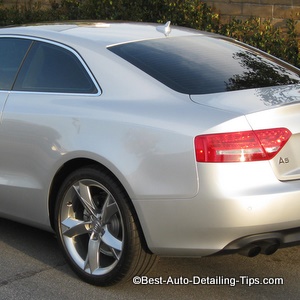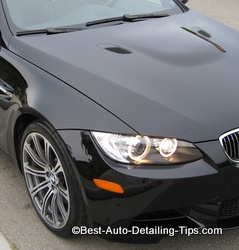Who Has the Best Car Paint ?
Who has it, who doesn't ?
One of the most common questions I get asked on my journey through the world of professional auto detailing is:
"So, who really has the best car paint?"
And I get it—you probably want a quick, clean answer. Maybe something like “Oh, that's easy—Porsche,” or “Mercedes, hands down.” But here's the truth: it’s not that simple. Not even close.
See, answering that question isn’t like picking a favorite color or brand. It’s like asking a chef what the best ingredient is—context matters. To give you a real answer, I need to break it down into the different layers of what makes paint “great”: things like finish quality, depth, hardness, consistency, how it reacts to light, and how well it holds up to the elements.
I’ll be honest—what I’m about to say might challenge your expectations. It might even frustrate you. But more importantly, it’ll open your eyes. Because when it comes to car paint, just like anything worth knowing in life, the truth lives in the details—not in a one-word answer.
Let Me Complicate the Question

When someone asks me, "Who makes the best car paint?"—I know there’s a deeper conversation waiting to happen.
Because that single question can mean very different things to different people. What sounds like a simple inquiry is often a tangle of unspoken specifics. So before I can even begin to answer, I usually have to ask:
- Are you asking which manufacturer produces the most durable paint?
- Or do you mean who has the thickest clear coat?
- Maybe you’re thinking about refinement—which brand finishes their paint with the highest level of precision—zero to little orange peel affect.
- Or maybe you are really wondering which paint color is the easiest to maintain and keep looking sharp?
As you can see, “best” can take many forms—and the real meaning often hides behind that one-word question. Each person comes in with a different idea, shaped by their own experiences, expectations, and priorities.
With that in mind, I’ll break it down into the most common areas of interest I’ve encountered throughout my professional experience—so you can decide for yourself what “best” really means to you.
Who Has the Most Durable Paint
Unfortunately, no one can really say for sure. Most every car manufacturer has had problems with their paint quality and durability at some point in their history.
From the early clear coats that would peel, or metallic's that would burn out, to some of the Chevy, Ford, or Chrysler products that would peel after a few years.
All the detailing in the world would not have saved any of these problems; this is a case of poor materials, preparation, base coats, clear coats, etc.
Who Has the Thickest Paint?
Once again, this depends. Most every car comes as a two stage paint, which is what clear coat (top coat) and base coat (color coat) is all about.
You get a thin layer of the color coat, which is followed by a thin layer of clear coat. So even if you were to measure the thickness with a paint gauge meter, how does one know how thick the actual clear coat is vs. the color, or base/primer coats— you wouldn't.
Which Manufacturer Finishes Their Paint Best?

This is an area we at least have a chance in answering, although it will still vary within a manufacturers product line. But overall I have an opinion based on an overall rule.
Orange Peel
This is a term that refers to paint texture. Imagine the skin of an orange and you will know what I am talking about here. The ideal paint surface is completely flat, smooth, and scratch free. The flatter and blemish free a paint surface is, the more the paint will look like a mirror. This picture to the left of this $100K Mercedes had one of the worst examples of Orange peel I have ever seen; and yes, this was original paint.
If you look at the picture closely, you can see the reflection of my detailing van and how the edges are wavy and uneven; this is due to the orange peel effect.

The paint on this BMW M3 was very close to perfect as far as paint texture goes. As the saying goes, you generally get what you pay for. Of course, exceptions always exist as was the case with the Mercedes from above. If I was forced to list the best car paint finish by manufacturer, it would go something like this:
Top Tier or A grade
- Ferrari
- Porsche
- Lamborghini
- Lexus
- Acura
Second Tier or B grade
- Jaguar
- Chrysler
- BMW/ Mini Cooper
- Audi
- Jeep
- Hummer
- Honda
- Infinity/Nissan
Third Tier or C grade
- Mercedes
- Chevy/GMC
- Range Rover
As you can see, I didn't include everyone on the list. The reality is that even within the manufacturers own line of cars, each model will have their own unique levels of orange peel.
Which Car Paint Color is the Easiest to Take Care of?
This is one of the most common questions I hear:
“What’s the best car paint color for easy maintenance?”
It’s a fair question—but often oversimplified. Most people are really asking, “Which color hides dirt, swirls, and imperfections the best without constant cleaning?”
Here’s the short version:
The darker the paint, the harder it is to maintain.
Let me break it down:
- Non-metallic black is by far the most difficult to keep looking clean and flawless.
- Metallic black is only slightly more forgiving, but still a challenge.
- Champagne (or taupe) takes first place as the easiest color to maintain—surprising, right?
Most people assume white is the winner. And while it’s definitely better than black, here’s why it falls behind:
- Champagne and silver are closer to the natural color of dust, which is the most common culprit in making a car look dirty.
- White, on the other hand, tends to highlight road grime—especially the kind that kicks up along your lower panels after a drive.
So if low-maintenance is what you’re after, your best bet is:
- Champagne/Taupe
- Silver
- White
It’s not the flashiest answer—but it’s the truth from years of detailing experience.
In Conclusion to Best Car Paint....
So, when someone asks, “What’s the best car paint?”—the honest answer is: it depends.
Just like beauty is in the eye of the beholder, the “best” paint really comes down to what you value most. Are you after durability? Easy maintenance? A deep, mirror-like finish? Or maybe just a color that hides dust between washes?
The truth is, this seemingly simple question is packed with complexity—and now that you know more about the variables than 90% of people out there, you’re already ahead of the curve.
And speaking of making your car look its best...
Be sure to check out my page on the best car wax—my go-to pick that can help any vehicle, no matter the color or condition, shine like it belongs on the showroom floor.
Because no matter what paint you’ve got, the right care brings out the best in it.
Sincerely,
Darren Priest
- Home
- Auto Detailing Tips
- This Page
|
|

